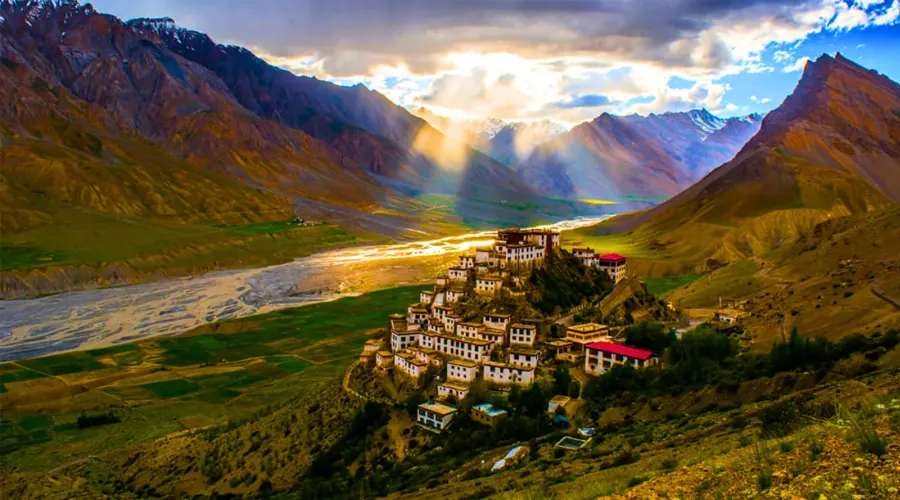Manikaran Sahib Gurudwara, Himachal Pradesh
The sanctity of God welcomes everyone who needs Him. This belief finds devotees of various religious inclinations at places of different faiths. One of the best examples is presented by Manikaran, 41 Km away from the hill station of Kullu in Himachal Pradesh.
This place in the Kullu district holds importance for both Hindus and Sikhs, for different beliefs but for the same reason of finding peace. Located in the Parvati Valley jointly formed by the rivers Beas and Parvati, Manikaran is revered by the people of both Hindu and Sikh religions. The former relates the place with the resettlement done by the Lord Manu after the 'Great Flood' and the latter is associated with the arrival of Guru Nanak founder of the Sikh religion. As a result, a Gurudwara and many temples are present here marking the charisma of these two religions felt and impact intellect deeply.
History
Sikh Beliefs
Guru Nanak is known to be an extensive traveler throughout his lifetime. He visited not only different parts of India but also other parts of Asia. Hagiographic accounts of the Sikh Guru demonstrate that all of his travels were well classified according to their purpose. His four missionary travels are called Udasis. During the third Udasi, Guru Nanak frequented the small village of Manikaran with one of his choicest disciples, Bhai Mardana. Back in that year 1574, the idea of a community kitchen was still being popularized by him. Once the Guru and his disciple reached the place, they found themselves starving. Bhai Mardana asked the villagers to donate some raw grains and vegetables, such that he and his master could be sated. The villagers were generous enough to give flour and some other grains. However, the raw food had to be cooked, but lighting a fire seemed extremely challenging in a cold valley with limited resources. This dilemma was countered by the great Guru when he instructed his disciples to lift a mysterious stone from its spot. As soon as Bhai Mardana lifted the stone, hot water sprung from beneath it. This boiling water provided enough heat to cook food. However, the rice and the rotis kept sinking in the water, making it difficult for Mardana to cook anything. When Guru Nanak observed the same, he asked his disciples to chant, “I am going to donate my life in the name of God.” As soon as he said this, the drowned items floated back up.
This incident prompted Guru Nanak to declare one of his most cherished teachings – anything devoted to God will never drown. This miracle prompted devotees to worship that very spot and build a Gurudwara there to commemorate the Guru’s life and teachings. The vast white Gurdwara stands at that exact spot where Guru Nanak and Bhai Maradana cooked langar. Its beautiful complex continues to enchant visitors. It gives everyone a calm surrounding to meditate and synchronize their energy for the betterment of their lives. Every day at the Gurudwara, the Gurbani path is recited along with several other essential verses from the Guru Granth Sahib. Langar, a charitable community dining program run by gurudwaras all around the world, is also served here. Kadhas, an Indian soup made from herbs, is served to every devotee that visits here. This soup has medicinal properties and cures many lung and throat diseases.
Hindu Mythology
The Hindu Mythology surrounding Manikaran Sahib provides a basis for its naming. According to legends, Lord Shiva and his consort Parvati were once exploring the hilly surroundings and the serene forests of the place. Shiva decided to meditate while Parvati took a bath. During bathing, Parvati lost a jewel that she was wearing, and a serpent in the river stole it. Angered by his inability to find the gem, Shiva did his Tandava dance and warned the snake to return Parvati’s earring. The serpent gladly offered the jewel to the Lord and apologized. Manikaran became the name of the place because the Hindi translation for the phrase earring is Manikaran.
Rishi Vedyas predicted the arrival of Guru Nanak at Manikaran in the Bhavishya Purana, further linking the Hindu and Sikh myths of this holy spot.
The Medicinal Hot Springs
The highly revered Manikaran gurudwara is mentioned in the Twelfth Khalsa, written by Giani Gian Sikh. A tunnel-like corridor inside the Gurudwara leads to a room called the garam Kothi. This is where the therapeutic hot spring exists. As a tourist, you might find the heat inside this room unbearable, but once you get accustomed to it, you will feel relieved.
The hot boiling spring in and around this Gurudwara is of great use both to locals and tourists. These hot springs are known to contain traces of metals such as Sulphur and Uranium, which have healing properties. Pilgrims take a dip into these hot springs a get a respite from the chilling cold that grips the Manikaran Valley. As a tourist, you can try a fun experiment to test the usefulness of the hot spring waters. Buy a muslin potli of rice from the nearby markets and dip it in the spring. You will watch the rice being cooked right in front of your eyes. This property of the spring is utilized by the Gurudwara management to cook food for devotees that visit the place to consume langar or prasad. The shopkeepers of the nearby bazaars use the water of the hot springs situated within the Gurudwara through pipes.
An incredible union of cold and hot water is seen in the Parvati river, producing steam that blends exquisitely with the white surroundings. These springs and their healing properties have intrigued scientists for years.


.webp)























